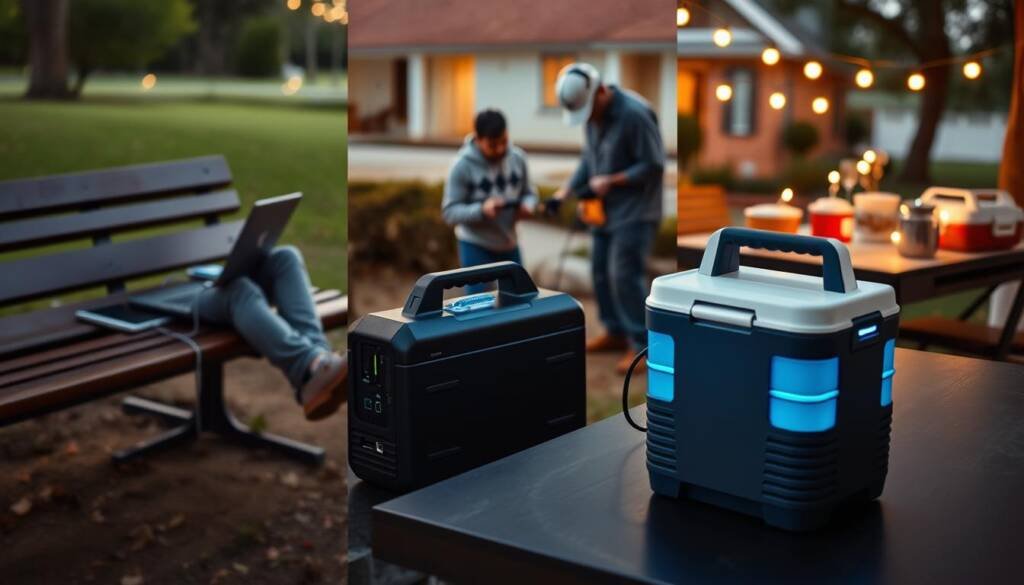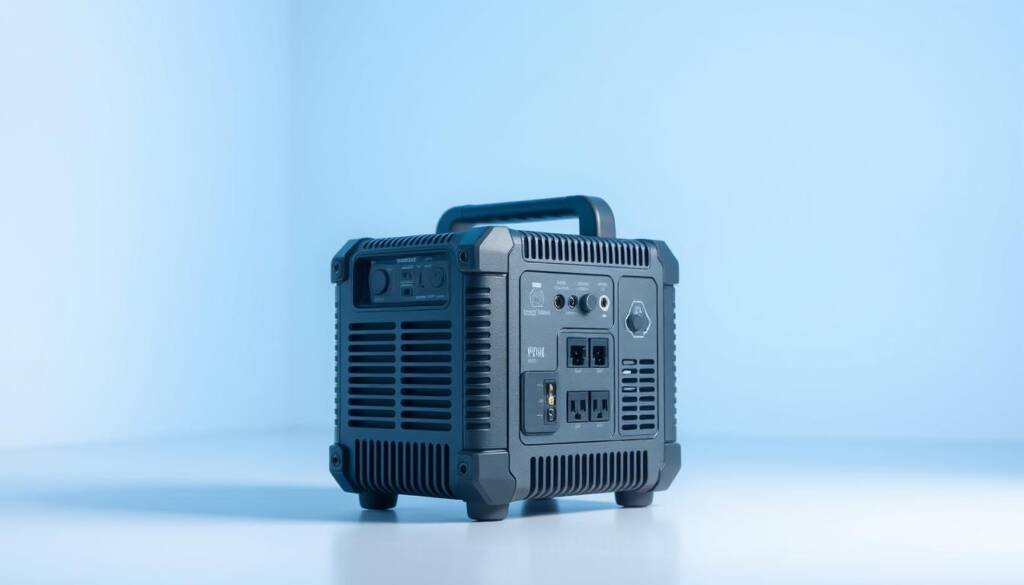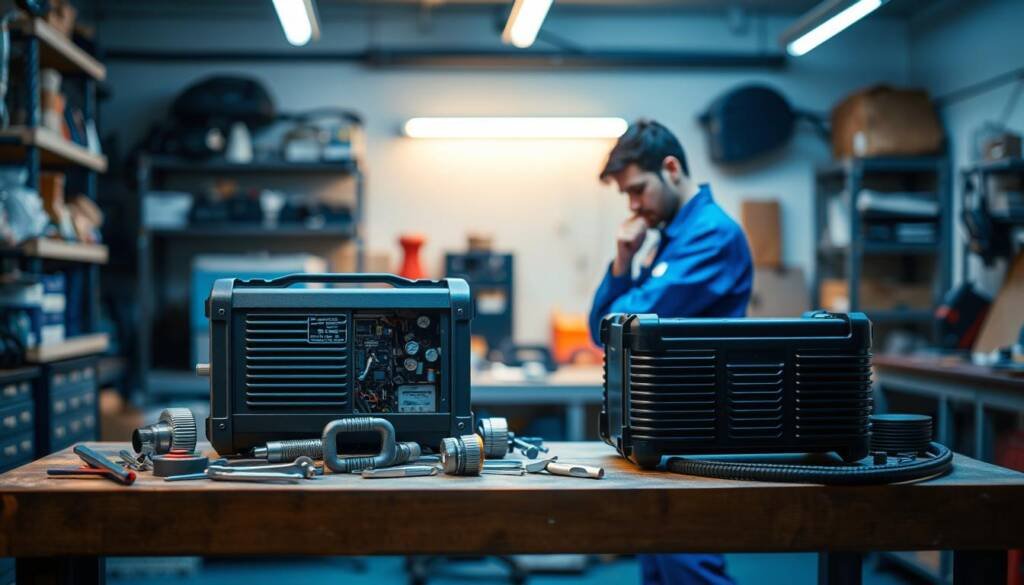Did you know that 60% of portable power station users underestimate their device’s runtime during outages? This surprising statistic highlights the importance of understanding how long a portable power station in various scenarios. As experts in sustainable energy solutions, we’re here to shed light on this crucial aspect of emergency preparedness.
Portable power stations have become indispensable tools in our tech-driven world, offering reliable and mobile power sources for countless applications. Whether you’re facing an unexpected blackout or planning an off-grid adventure, knowing the lifespan of your power station is key to staying connected and powered up.
In this comprehensive guide, we’ll explore the factors that determine a portable power station’s duration during outages. From battery capacity to usage patterns, we’ll equip you with the knowledge to make an informed decision when choosing the right power station for your needs.
Key Takeaways
- Portable power station lifespan varies from 3 to 10 years
- Battery type significantly impacts longevity and performance
- Usage patterns and maintenance affect overall runtime
- Proper care can extend a power station’s life beyond expectations
- Understanding power consumption helps optimize usage during outages
Understanding Portable Power Stations
Portable power stations are game-changers in the world of energy solutions. These devices pack a punch, offering reliable power for various situations, including unexpected outages. Let’s dive into what makes these units tick and why they’re becoming increasingly popular.
What is a Portable Power Station?
A portable power station is a high-capacity battery housed in a durable case. It’s designed to provide power on the go, featuring multiple outlets to operate or charge different devices. The longevity of portable power stations varies, with some models offering up to 500 full charge cycles. This translates to a lifespan of about 2-3 years under typical use.
Key Features of Portable Power Stations
Portable power stations come with several essential features that contribute to their versatility and efficiency:
- Battery capacity: Ranging from 100Wh to over 2000Wh
- Multiple output ports: USB, AC, and DC outlets
- Charging options: Wall outlet, car charger, and solar panels
- Display screen: Shows battery life and power consumption
The battery life of power stations depends on usage patterns and environmental conditions. For instance, a 1000Wh unit can power a 200W refrigerator for about 5 hours. Regular maintenance and proper storage can significantly extend the lifespan of these devices, potentially lasting 10 to 30 years.
Battery Capacity Explained
Understanding battery capacity is key to determining the average usage time of power stations. Portable power stations are rated by capacity, usually in watt-hours (Wh), which indicates how much energy the battery can store.
What is Watt-Hour (Wh)?
Watt-hour is a unit of energy measurement. It represents the amount of power a device consumes over time. For example, a 1000Wh power station can run a 100W device for 10 hours (1000Wh ÷ 100W = 10 hours).
Storage Capacity and Duration
The storage capacity directly affects how long a portable power station can last during an outage. A higher Wh rating means more energy storage and longer run times. For instance, Jackery offers portable power stations with capacities ranging from 240W to 3000W, catering to various needs.
The durability of portable power stations is influenced by battery technology. High-quality lithium-ion batteries are common in modern power stations due to their superior energy density and longevity. Jackery’s portable power stations are designed to operate efficiently for 500 full charge cycles, equating to about 2-3 years of usage.
- Lithium-ion batteries: 500-1,000 cycles
- Lead-acid batteries: 200-500 cycles
- Lithium Iron Phosphate (LiFePO4): 2,000-5,000+ cycles
To maximize the lifespan of your power station, avoid deep discharges and maintain a depth of discharge between 20% and 80%. Regular maintenance and proper storage can significantly enhance the durability of portable power stations, ensuring reliable performance during power outages.
Factors Influencing Duration
Understanding the portable power station runtime is crucial for making informed decisions about power management during outages. Several key factors affect how long a power station can sustain your devices.
Power Consumption of Devices
The energy demand of connected devices directly impacts the power station performance over time. A 50-watt device can theoretically run for ten hours on a 500Wh power station. Higher-wattage appliances drain the battery faster, reducing overall runtime.
Efficiency Ratings of Portable Power Stations
Power stations with higher efficiency ratings convert more stored energy into usable power. Advanced models use lithium-ion batteries and smart management systems to optimize energy delivery. The Jackery Explorer 1500 Pro, popular in the EU market, exemplifies this efficiency.
External Conditions
Temperature and usage patterns significantly affect portable power station runtime. Extreme temperatures can reduce battery performance. In northern EU countries, users should protect their units from snow and humidity. Southern European users need to shield power stations from direct sunlight.
- Ideal temperature range: 15°C to 25°C (59°F to 77°F)
- Maximum storage temperature: 30°C (86°F)
- LiFePO4 batteries operate between -20°C to 60°C (-4°F to 140°F)
By considering these factors, you can better estimate your power station’s runtime and optimize its performance during outages. Regular maintenance and proper usage can significantly extend the lifespan of your portable power station.
Typical Usage Scenarios

Portable power stations offer versatile solutions for various situations. Understanding these scenarios helps in estimating power station lifespan and maximizing portable power station longevity. Let’s explore common use cases and their impact on battery life.
Home Appliances
During power outages, portable power stations become lifelines for essential home devices. A 1000Wh station can run a 60W laptop for about 14 hours or a 300W desktop for 2.8 hours. For critical medical equipment like CPAP machines (40W), it provides roughly 21 hours of operation.
Outdoor Activities
Camping trips and outdoor events benefit greatly from portable power. A well-maintained station can power small appliances, charge phones, and run lights. For example, a 500Wh unit can theoretically operate a 50W device for 8.5 hours, accounting for efficiency losses.
Emergency Situations
In emergencies, power stations prove invaluable. They can keep communication devices charged and run small refrigerators to preserve medications. The longevity of your power station in these scenarios depends on usage patterns and environmental conditions.
- Lithium-ion batteries typically last 500-1000 charge cycles
- LiFePO4 batteries can exceed 2000-7000 cycles
- Optimal use: 20% to 80% depth of discharge
- Best performance: 32°F to 104°F (0°C to 40°C)
Remember, regular maintenance and proper storage significantly extend your power station’s lifespan. Charge it every 3-6 months when not in use, and store it in a cool, dry place for optimal longevity.
Comparing Different Models
When considering how long a portable power station lasts, it’s crucial to compare different models. The portable power station lifespan varies greatly depending on capacity and features. Let’s explore popular brands and their durations, as well as the differences between high-capacity and standard models.
Popular Brands and Their Duration
EcoFlow Delta 2 Max stands out with its 2,048Wh capacity and impressive 19-hour runtime for a fan. The Anker Solix C1000 offers 1,056Wh capacity and can power a fan for 9 hours. Jackery Explorer 880, with 880Wh, provides 7 hours of fan operation.
High-capacity vs. Standard Models
High-capacity models like the EcoFlow Delta 2 Max offer longer runtimes and more power output. They’re ideal for extended power outages or heavy-duty use. Standard models such as the Anker Solix C300 with 288Wh capacity are more portable and suitable for shorter trips or lighter power needs.
- High-capacity: EcoFlow Delta 2 Max (2,048Wh, 50.7 lbs)
- Mid-range: Anker Solix C800 (768Wh, 23.1 lbs)
- Standard: Anker Solix C300 (288Wh, 9.1 lbs)
When choosing a portable power station, consider your specific needs. High-capacity models last longer but are heavier, while standard models offer better portability at the cost of shorter runtimes. Your choice will impact how long your portable power station lasts during use.
Power Management Tips

Mastering power management extends the longevity of portable power stations. Smart usage habits boost battery life and ensure reliable power during outages. Let’s explore strategies to optimize your power station’s performance.
Optimizing Device Usage
To maximize the battery life of power stations, follow these tips:
- Recharge when capacity drops to 20-30%
- Avoid overcharging to prevent battery degradation
- Use manufacturer-specified chargers to prevent overheating
- Keep power stations away from extreme temperatures
- Turn off unused features to conserve energy
Prioritizing Power for Key Devices
Effective power distribution is crucial for extending portable power station longevity. Start by powering high-wattage devices when the battery is full. As charge decreases, switch to lower-wattage devices. This approach ensures critical equipment remains operational longer during outages.
Remember, adhering to the power station’s maximum output capacity prevents stress on internal components. For professional use, look for models with features that prioritize essential devices during critical situations. This focus allows you to manage power efficiently and tackle important tasks first.
By implementing these power management strategies, you’ll significantly increase your portable power station’s lifespan and maintain a reliable power source during extended outages.
Charging Options
Portable power stations offer versatile charging methods to keep your devices powered during outages. Understanding these options can help extend the average usage time of power stations and improve their durability.
Solar Charging
Solar panels provide a sustainable way to recharge your power station. This method is especially useful during extended power outages or outdoor adventures. Many portable power stations, like the Jackery Explorer series, come with compatible solar panels. Solar charging efficiency depends on factors such as sunlight intensity and panel placement.
Wall Outlet Charging
Wall outlets offer the fastest charging option for most portable power stations. For example, the EcoFlow Delta Max 2000 can charge from 0 to 80% in just 65 minutes when plugged into a standard household outlet. This quick charging capability enhances the durability of portable power stations by ensuring they’re ready for use when needed.
Car Charger
Car chargers provide a convenient way to power up your station while on the go. This option is particularly useful for road trips or when evacuating during emergencies. The Bluetti AC60P, weighing only 20.1 pounds, can be easily charged in your vehicle, making it a versatile choice for various situations.
By utilizing these charging options effectively, you can maximize the average usage time of power stations and ensure they’re always ready to support your energy needs. Remember, regular charging and proper maintenance can significantly extend the lifespan of your portable power station, with some models lasting up to 2-3 years under normal use.
Maintenance for Longevity

Proper care of your portable power station is crucial for maximizing its runtime and performance over time. With the right maintenance, these devices can serve you reliably for years.
Battery Care Tips
To extend your portable power station runtime, keep the battery charge between 20% and 80%. This practice helps preserve the battery’s health, as deep discharges and full charges can reduce its lifespan. Lithium-ion batteries, common in modern power stations, offer superior energy density and longevity when cared for properly.
Storage Recommendations
Store your power station in a cool, dry place to maintain optimal performance over time. Excessive heat or humidity can shorten battery life and affect overall efficiency. For long-term storage, charge the battery to about 50% every three months to prevent capacity loss.
- Clean the unit regularly to prevent dust buildup
- Inspect cables and connections for wear
- Avoid overloading the power station
- Monitor battery capacity and performance
Following these guidelines can significantly improve your power station’s longevity. With proper care, some portable solar power systems can last 10 to 25 years, ensuring reliable performance during power outages and outdoor adventures for years to come.
Real-Life Examples
Understanding portable power station longevity helps users make informed decisions. Let’s explore real-world scenarios to grasp how these devices perform during outages and outdoor adventures.
User Reports on Usage Duration
Campers often rely on portable power stations for weekend trips. A 500Wh unit can typically handle multiple devices:
- LED light (10W): 5 hours/night = 50Wh
- Smartphone (10W): 2 hours/day = 20Wh
- Laptop (50W): 3 hours/day = 150Wh
This setup consumes about 220Wh daily, allowing for a 2-3 day trip on a single charge. The estimation of power station lifespan varies based on usage patterns and environmental factors.
Case Studies During Outages
During a recent power outage, a family used the Jackery Explorer 1000 V2 to power essential appliances. With its 1070Wh capacity and 1500W output, it ran:
- Refrigerator: 8 hours
- Lights: 12 hours
- Smartphones: Charged multiple times
The power station lasted nearly 24 hours before needing a recharge. This real-world example demonstrates the practical portable power station longevity in emergency situations.
For those seeking extended power, the Anker Solix F3800 offers 3840Wh capacity and 6000W output. It can run most household appliances for several days, showcasing the range of options available for different needs and scenarios.
Cost Considerations
When exploring portable power station options, understanding the price range and weighing the costs against benefits is crucial. The market offers a wide spectrum of choices, catering to various needs and budgets.
Price Range of Portable Power Stations
Portable power stations come in different sizes and capacities, reflecting a broad price range. Budget-friendly options start under $200 for smaller jobs. Mid-range models, suitable for powering essential home appliances during outages, can cost between $2,000 to $3,800. High-capacity units, capable of running multiple devices simultaneously, may exceed $3,800.
Cost vs. Benefit Analysis
When considering how long a portable power station lasts, it’s essential to factor in both immediate and long-term benefits. Smaller units with capacities up to 2,000 watts can power a fridge, lights, and phone chargers during short outages. Larger 6,000-watt stations can run central air conditioning when connected to a home’s breaker panel.
The portable power station lifespan varies depending on the model and usage. Some are designed to operate efficiently for 500 full charge cycles, translating to about 2-3 years under typical conditions. High-end models can last 10 to 30 years with proper maintenance.
- Small power stations (up to 2,000 watts): Best for basic needs
- Mid-sized power stations (up to 3,500 watts): Ideal for longer outages
- Large power stations (up to 6,000 watts): Suitable for powering multiple appliances
Investing in a portable power station aligns with the growing trend of renewable energy solutions. The European portable power station market is projected to reach $120.3 million by 2030, reflecting increasing demand and technological advancements in this sector.
Conclusion: Making an Informed Choice
Portable power stations have become essential tools for managing power outages and outdoor adventures. The longevity of portable power stations varies widely, with factors like battery type and usage patterns playing crucial roles. For instance, LiFePO4 batteries can last 5-7 years, while Li-ion batteries may need replacement after 3-5 years.
Key Takeaways on Duration and Use Cases
The battery life of power stations is a critical consideration. Jackery portable power stations, for example, are designed to operate efficiently for 500 full charge cycles, equating to a lifespan of 2-3 years under optimal conditions. For home backup, Jackery generators can last 10-30 years with proper maintenance. The European portable power station market is projected to reach $120.3 million by 2030, reflecting growing demand.
Final Recommendations for Purchasing
When selecting a portable power station, consider your specific needs. Jackery offers options ranging from 240W to 3000W, catering to various energy requirements. The Explorer 1500 Pro is popular in the EU market, featuring multiple output interfaces. Remember, higher capacity generally means longer runtimes. For refrigerators, aim for at least 500 watts. Lastly, opt for models with pure sine wave inverters to ensure clean, consistent power for sensitive appliances.